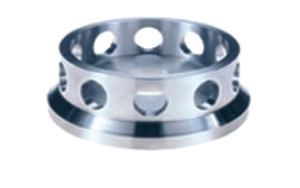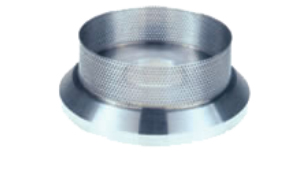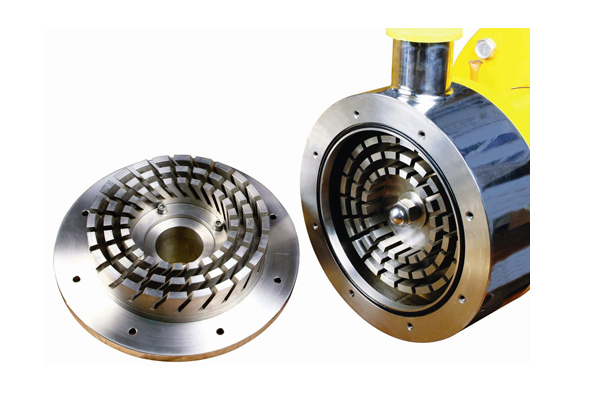DESCRIPTION
The Jaguar Inline Homogenizer offers a clean, high-performance solution at the highest technical level. It is marked out by first-class production performance and exceptional hygiene levels. Optimized design of the product chamber eliminates dead zones and the machine is simple and easy to clean. It is ideal for processing even the most sensitive products and the wide range of option Sen sures extreme flexibility. Based on the principle of a multi-chamber rotor/stator system,
the Inline Homogenizer is suitable for emulsification and suspension of fluid products. Product is introduced via a pump into the first chamber, where a special mixer/feeder combination premixes the product and feeds it to the toothed rotor/stator system – a high-performance homogenizer. The product is then sheared the high level of shear forces in the shear gap and high-energy turbulence at the rotor channel out feed ensure excellent product quality. When processing emulsions, this unit can achieve particle sizes down to 1 μm with a fine distribution. When dispersing suspensions, powder solids are wetted, de-agglomerated and homogenized until the desired product quality is achieved.
The homogenizer is designed for use in line In Inline agitation system, the possibility of materials –Liquid or Solid passing through it, without subjected to intense hydraulic and mechanical shear actions is zero. Here suction pipe (inlet pipe) is centrally mounted & outlet is radially mounted, therefore it is physically impossible for any material to pass from inlet to outlet without exposed to agitation.
The stator which surrounds rotor is available with various type of opening i.e. round, square, rectangular & with perforation also so that all the critical demand of Mixing, Emulsifying, Disintegration & Dispersion of solids, suspension can be met out by same equipment. The machine is versatile & has completely revolutionized the traditional mixing techniques. Here close tolerance of rotor with the stator produces high hydraulic shearing & mechanical action that ensures that material entrapped between rotor & stator is subjected to tremendous shearing actions each minute.
HOMOGENIZER
The Jaguar Inline Homogenizer offers a clean, high-performance solution at the highest technical level. It is marked out by first-class production performance and exceptional hygiene levels. Optimized design of the product chamber eliminates dead zones and the machine is simple and easy to clean. It is ideal for processing even the most sensitive products and the wide range of option Sen sures extreme flexibility. Based on the principle of a multi-chamber rotor/stator system.
The Inline Homogenizer is suitable for emulsification and suspension of fluid products. Product is introduced via a pump into the first chamber, where a special mixer/feeder combination premixes the product and feeds it to the toothed rotor/stator system – a high-performance homogenizer. The product is then sheared the high level of shear forces in the shear gap and high-energy turbulence at the rotor channel out feed ensure excellent product quality. When processing emulsions, this unit can achieve particle sizes down to 1 μm with a fine distribution. When dispersing suspensions, powder solids are wetted, de-agglomerated and homogenized until the desired product quality is achieved.
The homogenizer is designed for use in line In Inline agitation system, the possibility of materials –Liquid or Solid passing through it, without subjected to intense hydraulic and mechanical shear actions is zero. Here suction pipe (inlet pipe) is centrally mounted & outlet is radially mounted, therefore it is physically impossible for any material to pass from inlet to outlet without exposed to agitation.
The stator which surrounds rotor is available with various type of opening i.e. round, square, rectangular & with perforation also so that all the critical demand of Mixing, Emulsifying, Disintegration & Dispersion of solids, suspension can be met out by same equipment. The machine is versatile & has completely revolutionized the traditional mixing techniques. Here close tolerance of rotor with the stator produces high hydraulic shearing & mechanical action that ensures that material entrapped between rotor & stator is subjected to tremendous shearing actions each minute.
HOMOGENIZING
High pressure homogenizers are used in a variety of applications, in the chemical and pharmaceutical industries, particularly in the preparation of emulsions. While they provide exceptional high shear rates and ultra-fine globule size, these devices have high capital, operating and maintenance costs.
Homogenization of many products can be carried out using a high shear mixer. In many cases, the fine globule or particle size obtained – typically in the range of 0.5 to 5 microns – is sufficient for process requirements, eliminating the need for further processing. However, where a high-pressure homogenizer must be used, passing the product through In-Line Homogenizer first will highly improve throughput, process efficiency and reduce operating costs. This is because high pressure homogenizers work better when fed with a premix of uniform and fine globule or particle size, allowing the product to pass through the homogenizer at a much faster rate, normally in a single pass.
Some homogenizers offer multistage rotor/stator configurations and special ultra-fine stator screens which provide intense high shear, further reducing homogenization times by reducing the number.
FLUID MIXING MECHANISMS
In terms of mechanical mixing mechanisms, a number of actions are employed by different types of mixers to create different effects for particular process results. For distributive action, swirl created by rotating parts causes laminar thinning of the material interfaces, thereby increasing volumetric combination of the materials. A repeated cutting and folding action of the mixture also increases the distribution of different material components. The effectiveness and efficiency of a mixer in distributive mixing is therefore a function of how the machine interacts with the fluid in a geometric sense.
Conversely, the effectiveness and efficiency of a mixer in dispersive mixing is a function of how the machine interacts with the fluid in a stressing sense. For most materials, the higher the stress, the smaller the resulting particles or droplets in the mixture. However, another very important consideration is the uniformity of the streSS field. Without a reasonable uniformity, it is impossible to guarantee that the same streSS is applied to all parts of the fluid. This would result in a wide range of final droplet or particle sizes rather than a narrow range obtained with uniform stressing. One or more of the three primary stressing mechanisms are used in most fluid mixers
FLUID INLINE MIXERS
Usually called "high-shear mixers", are the most common form of Dispersing/Homogenizing/ Emulsifying mixer. By placing a form of closely-fitting shroud around a high-speed impeller, it is possible to create a shearing action between the blades and stator shroud. As material is centrifugally pumped through the mixing head, some of it will see this high shear zone and experience shear stressing that results in dispersive mixing. Where small or uniform dispersions are required, material must be cycled through the head many times to ensure statistically that all of the material has passed through the high shear zone at least on.
PUMPING ACTION
Because of indigenous design & rotor operating at very high speed in close clearance with stator draws the material in & imparts mechanical & shearing actions. Inline High Shear Mixer facilitates high volume, non positive action which is sufficient to transfer the material without any supplementary pumps but in some cases because of high viscosity, vertical lift or length of pipe line , the flow rate may come down below the anticipated value, In that case it is supplemented by an auxiliary pump installed in the system which pumps the liquid without reducing the homogenizing/emulsifying efficiency of the system.
RECIRCULATORY PROCESSING
There are certain proceSSes which demand higher degree of homogenization, dispersion, commination & but to attain that level, single passage of material through Inline is not sufficient to reach that degree, in that situation, it is more useful to pass the product several times through the same machine by means of recirculation. The above process is normally adopted in producing emulsion of Oil & Water. Oil, which is lighter than water is charged in the holding vessel & water is added into the pipe line between vessel outlet valve & Inlet of Inline Emulsifier. This mix is immediately sucked into the head of emulsifier & there mixing/ emulsification/ homogenization takes place. This mix is then sent into the vessel. This process is repeated till achievement of perfect emulsion. Where viscosity is very high or vessel size is large, it is recommended to go for Batch type mixer along with Inline Mixer.
POWDER/LIQUID-MIXING
Dispersing powders into liquids and creating a consistent, homogeneous product, time after time, is one of the most difficult mixing tasks. Homogenizers have a range of products designed to provide the most efficient means of incorporating powders into liquids, the selection of which depends on factors such as the batch size, the type of ingredients and the viscosity of the end product.
A closed rotor-stator homogenizer can rapidly incorporate high percentages of powders and can handle relatively high viscosity mixes. It is particularly suitable for incorporating difficult powders with a tendency to float. For bulk powder dispersion, different homogenizers offer a unique powder and liquid mixing system.
PARTICLE SIZE REDUCTION
The high shear Homogenizer rotor/stator can achieve rapid and uniform milling of both solid and semisolid materials to a low micron size in a single operation. The degree of particle size reduction will depend on the hardness of the product. Where conventional milling equipment is required, pre-milling the product with Homogenizer will create a uniform premix that will pass through the conventional mill at a much faster rate, because media mills work best when fed with a product of a consistent and low particle size. For particle size reduction many equipment’s offer a range of single and multistage in-lines and the Multi shear Homogenizer. To reduce the size of the products, high pressure homogenizers are used in Bio Parma Industry.
GENERAL PURPOSE DISINTEGRATING HEAD

Used for a wide range of applications, this head will give the greatest throughput. Suitable for the blending of liquids of similar or greatly varying viscosities, its uses include the disintegration of solid and semi-solid materials.
SQUARE HOLE HIGH SHEAR SCREEN

The configuration and fine internal tolerances of this stator provide exceptionally high shear rates which are ideal for the rapid size reduction of soluble and insoluble granular solids. It is also suitable for the preparation of emulsions, gels and thickeners and fine collodial suspensions.
SLOTTED DISINTEGRATING HEAD

For the disintegration of fibrous materials such as animal and vegetable tissue, as well as the disintegration and solubilization of “elastic” materials such as rubbers and polymers.
EMULSOR SCREENS

These screens are suitable for liquid/liquid preparations and are especially useful for all emulsions. Emulsor screens are available in fine, medium or coarse perforations.
KEY FEATURES
- Continuous Processing : Unlike batch mixers, inline mixers operate continuously, allowing for a constant flow of materials and finished product.
- High Throughput : Inline mixers are designed for large-scale production, capable of handling high volumes of materials efficiently.
- Uniform Particle Size Reduction : The intense shear forces generated by these mixers break down particles and achieve consistent particle size distribution.
- Scalability : Inline mixers can be scaled up or down, making them suitable for both small lab operations and large industrial facilities.
- Energy Efficiency : By reducing mixing time and achieving desired results in a single pass, inline mixers can be more energy-efficient than batch mixers.
ADVANTAGES
- Efficient and Rapid Mixing : The intense shear forces enable rapid blending and dispersion of materials, leading to faster processing times.
- Improved Product Quality and Consistency : Inline mixers produce homogeneous mixtures with consistent properties, resulting in higher quality products
- Enhanced Bonding Strength (for adhesives) : The uniform dispersion of adhesive components ensures stronger bonds.
- Reduced Production Time : Continuous mixing and efficient processing reduce overall production time.
- Cost Savings : Reduced processing time and energy consumption can lead to significant cost savings.
- Versatility : Inline mixers can handle a wide range of materials and viscosities, making them suitable for various applications.
- Flexibility : They can be customized to meet specific process requirements, such as handling different batch sizes or formulation complexities.
